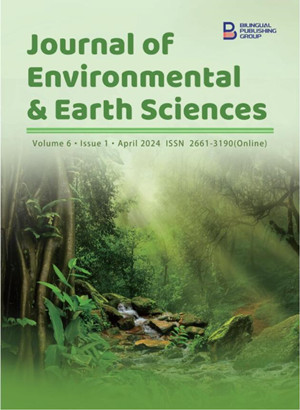
Exploring Variability in Sea Level at a Tide Gauge Station through Control Charts
DOI:
https://doi.org/10.30564/jees.v6i1.5983Abstract
Monitoring temporal changes in sea level is important in assessing coastal risk. Sea level anomalies at a tide gauge station, if kinematically conceived, include systematic variations such as trend, acceleration, periodic oscillations, and random disturbances. Among them, the non-stationary nature of the random sea level variations of known or unknown origin at coastal regions has been long recognized by the sea level community. This study proposes the analyses of subgroups of random residual statistics of a rigorously formulated kinematic model solution of tide gauge variations using X-bar and S control charts. The approach is demonstrated using Key West, Florida tide gauge records. The mean and standard errors of 5-year-long subgroups of the residuals revealed that sea level changes at this location have been progressively intensifying from 1913 to the present. Increasing oscillations in sea level at this locality may be attributed partly to the thermal expansion of seawater with increasing temperatures causing larger buoyancy-related sea level fluctuations as well as the intensification of atmospheric events including wind patterns and the impact of changes in inverted barometer effects that will alter coastal risk assessments for the future.
Keywords:
Climate change; Sea level variance; X-bar; S control chartsReferences
[1] Climate Change 2001: The Scientific Basis [Internet]. IPCC [cited 2002 Sep 24]. Available from: https://www.ipcc.ch/report/ar3/wg1/
[2] Lambeck, K., 1980. Earth’s variable rotation: Geophysical causes and consequences. Cambridge University Press: Cambridge. pp. 449.
[3] Pugh, D.T., 1987. Tides, surges and mean sea level. John Wiley & Sons Ltd.: Hoboken. pp. 300–330.
[4] Widlansky, M.J., Long, X., Schloesser, F., 2020. Increase in sea level variability with ocean warming associated with the nonlinear thermal expansion of seawater. Communications Earth & Environment. 1(1), 9. DOI: https://doi.org/10.1038/s43247-020-0008-8
[5] Woodworth, P.L., Melet, A., Marcos, M., et al., 2019. Forcing factors affecting sea level changes at the coast. Surveys in Geophysics. 40(6), 1351–1397. DOI: https://doi.org/10.1007/s10712-019-09531-1
[6] Bhatia, K.T., Vecchi, G.A., Knutson, T.R., et al., 2019. Recent increases in tropical cyclone intensification rates. Nature Communications. 10(1), 635. DOI: https://doi.org/10.1038/s41467-019-08471-z
[7] Emery, W.J., Emery, W.J., 2001. Data analysis methods in physical oceanography, second and revised edition. Elsevier: Amsterdam. pp. 373–374.
[8] Kendall, M., 1973. Time-series, second edition. Charles Griffin and Company Ltd.: London. pp. 70–85.
[9] İz, H.B., Ng, H.M., 2005. Are global tide gauge data stationary in variance? Marine Geodesy. 28(3), 209–217. DOI: https://doi.org/10.1080/01490410500204546
[10] Munk, W., Dzieciuch, M., Jayne, S., 2002. Millennial climate variability: Is there a tidal connection? Journal of Climate. 15(4), 370–385. DOI: https://doi.org/10.1175/1520-0442(2002)015<0370:MCVITA>2.0.CO;2
[11] Keeling, C.D., Whorf, T.P., 1997. Possible forcing of global temperature by the oceanic tides. Proceedings of the National Academy of Sciences. 94(16), 8321–8328. DOI: https://doi.org/10.1073/pnas.94.16.8321
[12] Yndestad, H., 2006. The influence of the lunar nodal cycle on Arctic climate. ICES Journal of Marine Science. 63(3), 401–420. DOI: https://doi.org/10.1016/j.icesjms.2005.07.015
[13] Yndestad, H., Turrell, W.R., Ozhigin, V., 2008. Lunar nodal tide effects on variability of sea level, temperature, and salinity in the Faroe-Shetland Channel and the Barents Sea. Deep Sea Research Part I: Oceanographic Research Papers. 55(10), 1201–1217. DOI: https://doi.org/10.1016/j.dsr.2008.06.003
[14] Iz, H.B., 2006. How do unmodeled systematic mean sea level variations affect long-term sea level trend estimates from tide gauge data? Journal of Geodesy. 80, 40–46. DOI: https://doi.org/10.1007/s00190-006-0028-x
[15] Iz, H.B., 2018. The effect of regional sea level atmospheric pressure on sea level variations at globally distributed tide gauge stations with long records. Journal of Geodetic Science. 8(1), 55–71. DOI: https://doi.org/10.1515/jogs-2018-0007
[16] Tide Gauge Data [Internet]. Permanent Service for Mean Sea Level (PSMSL). Available from: http://www.psmsl.org/data/obtaining/
[17] Hildreth, G., Lu, T., 1960. Demand relations with autocorrelated disturbances. Michigan State University Agricultural Experiment Station: East Lansing.
[18] Shewhart X-bar and S Control Charts [Internet]. National Institute of Standards and Technology. Available from: https://www.itl.nist.gov/div898/handbook/pmc/section3/pmc321.htm
Downloads
How to Cite
Issue
Article Type
License
Copyright © 2024 Author(s)

This is an open access article under the Creative Commons Attribution-NonCommercial 4.0 International (CC BY-NC 4.0) License.







 H. Bâki İz
H. Bâki İz






